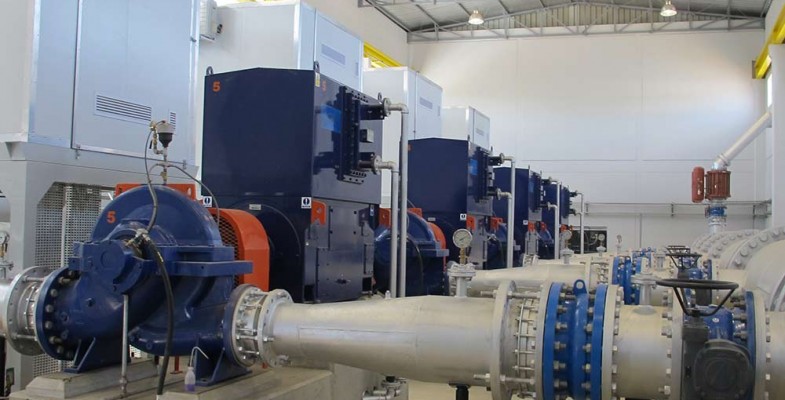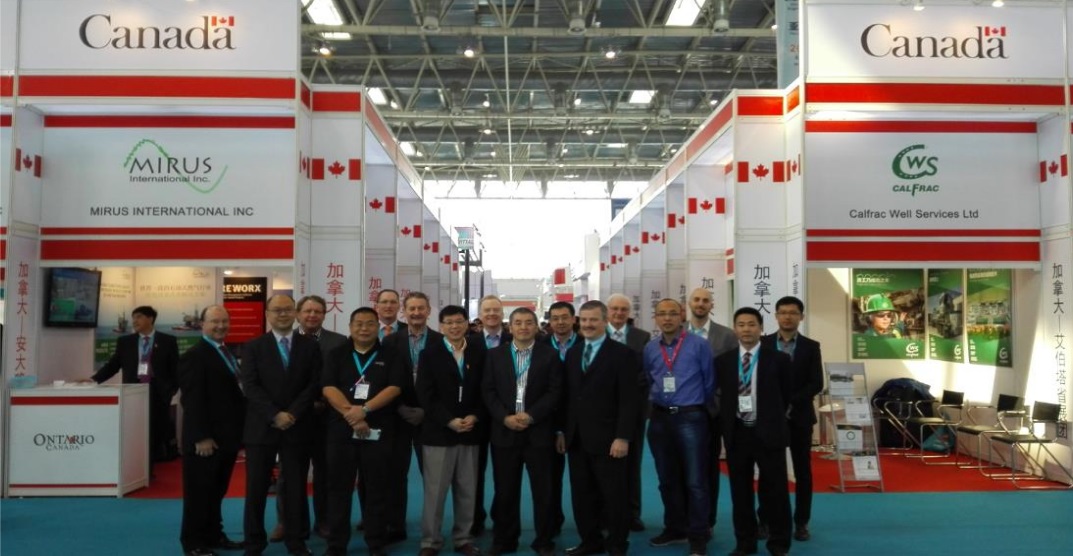Canadians too complacent about seeking export markets, report warns

JEFF GRAY
The Globe and Mail
Published Sunday, Mar. 29, 2015 9:20PM EDT
Tony Hoevenaars has long tried to sell his company’s complex electrical equipment in China, but it has been difficult. He blames the distances involved and Chinese duties and taxes.
“We do have some customers in China,” the CEO of Mirus International Inc., said in a phone interview from Beijing, where he is attending a trade show. “We don’t have a lot of customers – yet.”
His small firm, based in Brampton, Ont., makes electrical filters for high-powered drilling equipment used in the petroleum industry. And to finally break through to customers in China and across Asia, he seized the opportunity last year to buy an existing factory in Suzhou, with a loan guaranteed by Canada’s federal Export Development Corp.
It’s exactly the kind of bold move experts say too few Canadian small and medium-sized businesses are willing to make.
It’s a deficiency highlighted by the Toronto Region Board of Trade in its annual Scorecard on Prosperity report, which is being released on Monday. The report says small and medium-sized companies in Toronto and across Canada desperately need to export more to markets around the world, particularly in rapid-growth countries such as China. Failing to do so, the board warns, puts our future prosperity at risk.
Despite all the talk of globalization over the past few decades, very few small and medium-sized companies across Canada do any international trade at all. Only about 5 per cent of all Canadian companies of any size that could export their products actually do. And of Canada’s more than one million small and medium-sized businesses, only 41,000 actually export a single widget across the border. Compare that to Switzerland, where 69 per cent of small and medium-sized business sell their products in other countries.
It is a point that has been made before. But now, with oil prices sinking and the Canadian dollar lower – making Canadian goods cheaper on world markets – the time is ripe for Canadian small and medium-sized manufacturers to start selling their goods to the world, as the economy lurches away from dependence on Alberta’s oil patch.
Big cities across Canada are ideally suited to take advantage of this change and produce companies that do business more globally. Most of the country’s urban centres are home to large immigrant populations from Asia and other high-growth areas. The Board of Trade says businesses need to do a better job making use of the knowledge and connections that newcomers bring with them to make inroadsin China, India and elsewhere.
Those Canadian companies that do export now are usually quite comfortable trading only with the United States. But while it will always be Canada’s most important customer, and its economy is recovering, the United States will never match the skyrocketing growth rates now seen in China, India and elsewhere in Asia. That makes seeking other markets a key goal. But according to Ontario numbers in the report, that province has seen total exports fall between 2003 and 2013.
The decline can be blamed largely on our dependence on the United States, which consumes about 80 per cent of Canadian exports but has been struggling economically since 2008. While exports to China and elsewhere in Asia have grown, Ontario, for example, has been outpaced by rivals. Illinois now exports 2 1/2 times as much as Ontario does to China, despite exporting less to the Middle Kingdom than Ontario did a decade ago.
Turning this around is necessary, the Board of Trade says, because Toronto needs to do something about its declining rate of labour productivity, which fell 6 per cent between 2000 and 2010. It is the same story across the country: Among other Canadian cities, only Vancouver and Calgary have made even meagre productivity gains over the past five years, the board says.
Companies that export tend to be more productive, as they need to fend off global competition. The report says that with a growing number of workers hitting retirement age, the productivity of those still in the work force needs to rise to keep living standards, and government tax revenues, up. Boosting exports can help that happen, the board argues.
Jan De Silva, president and chief executive of the Board of Trade, says her organization is among other trade groups and government agencies trying to help smaller businesses go global. The board is launching what it calls a “trade accelerator” education program to help small businesses navigate the world of exports. Governments at all levels across the country also offer myriad subsidies and programs and assist with financing or simply making international connections. But still, the numbers are not encouraging.
“Probably the most disturbing graphic in the whole report that we’ve got is the one just showing the decline of trade in Ontario,” Ms. De Silva said. “… The reality is these markets in Asia have been booming in that period of time.”
Walid Hejazi, an associate professor of business at the University of Toronto’s Rotman School of Management, is skeptical that Canadian companies will ever truly break out of their timid export habits, or look too far beyond the large and conveniently located U.S. market. The result, he said, is a lack of a spur for companies to become more innovative.
“That’s why people say, being next to the U.S. has been a blessing, but it has come at the risk of us becoming complacent,” Prof. Hejazi said. “If we were forced to go into these [other] markets, we would be forced to do the things that we need to do.”
Whether more Canadian companies will rise to the challenge and go global remains an open question. Speaking on the phone from China, Mr. Hoevenaars, the CEO of Mirus, said Canadian companies should not be fearful of looking overseas for new markets: “I would say the biggest thing is not to be afraid of it. There are opportunities there, and you can be successful.”
Access ArticleMirus International Expands Its Harmonics Mastery to China
Simon Forsyth
Published December 17, 2014

In these days of non-linear loads, it is becoming increasingly important to mitigate harmonics in order to maintain power quality in various operations… Got it? No? Well don’t feel bad, even electrical engineers have trouble understanding this problem which plagues power systems around the globe.
Yet one Canadian company from Brampton, Ontario has made their name by doing what many could not – understanding harmonics. In fact, Mirus International not only understands harmonics better than most, they’ve become quite good at fixing the problem as well… they would even say the best.
“Harmonics is an extremely difficult problem to understand, but because we’ve all been working at it since the inception of this company and even before, we get it,” says Tony Hoevenaars, Mirus President and CEO.
“That’s why we are able to compete with the big international electrical companies, because of our expertise. Several times we’ve even been approached by clients who have had harmonics equipment installed by these big players, which hasn’t worked. We’re generally able to provide them with solutions that do work, and if we can’t meet their demands, we have no problem pointing them in the right direction.”
So what do they do exactly? Pay attention fellow laymen … this is tricky: When power enters a home or other power consuming entity, it does so at a fundamental frequency of 60 hertz (standard for North America). But electronic devices, or loads, that draw power from that supply don’t necessarily do so at the same frequency or linear waveform.
“Non-linear” devices, like computers, draw current in irregular pulses, which layer multiple frequencies on top of that fundamental, even-flowing 60 hertz frequency. These additional layers are referred to as harmonics. Think of them in the same way that voices layered on top of each other create harmonics (or harmony) in music. Capiche?
The problem is harmonics in power systems are not desirable like they might be in a barbershop quartet. They cause distortions in the power system that can lead to devices overheating or even failing. And when you’re talking about drilling equipment on oil rigs or electric propulsion systems on ocean fairing vessels, power failures or interferences aren’t really an option.
So long story short (ish), Mirus’s products fix harmonics problems. Their world-class filters and transformers clean out distortions within power systems to ensure that loads and devices draw that nice linear current, rather than that undesirable, harmonic-laden, Beach Boys style current. And their mastery of this very technical, but very important, niche of the electrical power sector is what sets them apart from their competition.
Last year the company was named one of the 500 Fastest Growing Companies in Canada by Profit Magazine, and this year Mirus was honoured at the Ontario Export Awards with the Emerging Exporter of the Year Award.
Hoevenaars estimates that 20 per cent of their sales are to Canadian customers, 35 to 40 per cent to the US, and the remainder to countries all over the world. But some markets are more difficult to penetrate than others. China in particular, presented a challenge for Mirus.
Severe taxes and tariffs on imports, coupled with long shipping times from Canada and premiums on transport combined to make China, and most of Asia-Pacific for that matter, a tough market to crack. So when an opportunity came along to acquire an operational factory in Suzhou, China, Mirus had to act quickly to gain a foothold in the fast-growing emerging market.
Mirus’s bank, RBC, was willing to provide $1 million in capital financing for the acquisition, but needed Export Development Canada (EDC) to guarantee the amount, because of the risk involved in an unsecured loan of this kind. EDC’s export guarantees help small and medium-sized business like Mirus, which may not have the assets to back a loan of this size and level of risk, to get the working capital they need to expand their international operations and grow
“We were happy to guarantee the financing for this acquisition as a move like this will help to makes Mirus more competitive in the Asian market … overnight,” said Megan Malone, EDC Small Business Account Manager. “They will be able to ship items faster, offer more competitive prices, and gain access to local supply chains. This really sets them up for growth in the Asia-Pacific region, and helping Canadian companies in this way is pretty much our MO.”
For Hoevenaars, it’s a big step forward, and an exciting one. “It’s a new challenge for us, but we’re confident in our products and our people, and we can’t wait to get started over there.”
Access ArticleMirus International Inc. Wins Ontario Export Award
November 25, 2014

Top Row (left to right): INKAS, David Khazanski, CEO; Mirus International, Tony Hoevenaars, President and CEO; Mircom, Shahul Hameed, Vice President -Strategic Development: MENAI Region; Christie Digital, Clint Carter, Senior Director, Global Manufacturing; Jaylor, Marty Philippi, International Business Development Manager; Bottom Row (left to right): NuForm, Eyal Eshed, Export Manager; Aeryon, Dave Kroetsch, CEO and Co-founder; Schulich, Snow Zhao, Student; Polycorp, Peter Snucins, CEO | Photo Credit: Donna Santos Photography
TORONTO — Aeryon Labs Inc. was named Ontario’s Exporter of the Year Nov. 25 at the inaugural Ontario Export Awards. The manufacturer of small unmanned aerial vehicles commonly known as “drones” also won the award for Consumer Products & Technology.
The Ontario Export Awards—the province’s most prestigious awards paying tribute to the success and innovative approaches of Ontario export companies—recognized top exporting companies in Ontario with awards in 10 categories. The awards are a celebration of the contributions exporters have made to both the provincial and national economy.
There was plenty of innovation on tap, with 26 companies vying for nine category awards. The finalists—all of which were small or medium-sized businesses— represented industries across Ontario’s goods-producing and services sectors.
The full list of winners includes:
- Emerging Exporter: Mirus International Inc. in Brampton, Ont.
- Clean Technology: Nuform Building Technologies Inc. in Woodbridge, Ont.
- Consumer Products & Technology: Aeryon Labs Inc. in Waterloo, Ont.
- Food, Beverage & Agriculture: Jaylor Fabricating Inc. in East Garafraxa, Ont.
- Services – Polycorp Ltd. in Toronto
- Value-Added Manufactured Goods: Mircom Group of Companies in Vaughn, Ont.
- Transportation Equipment: Inkas Armored Vehicle Manufacturing in Toronto
- Leadership: Christie Digital Systems Canada Inc. in Kitchener, Ont.
- Business Studies Student Award – Snow Zhao, Schulich School of Business, York University, Toronto
- Exporter of the Year – Aeryon Labs Inc. in Toronto
“As the organizer of the Ontario Export Awards, Business Information Group couldn’t be more pleased to have the opportunity to recognize and celebrate some of the province’s top exporters,” said Tim Dimopoulos, executive publisher with Business Information Group.
“Competition for the awards was tight, and we congratulate the significant achievement of those who made the finalist round, and those who won awards.”
The 2014 Ontario Export Awards were organized with the support of Canadian Manufacturers & Exporters (CME), Canada’s largest trade and industry association, and was sponsored by HSBC Bank Canada, UPS, Lincoln Electric Co. of Canada, Buffalo Niagara Enterprise and Port of Montreal.
Access Article
